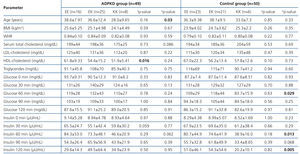Dear Editor,
Results of large-scale studies and meta-analyses1-4 strongly indicate that K23 allele is associated with higher prevalence and incidence of type 2 diabetes in adult Caucasians. Some studies1,5 have shown that the K allele may have a diabetogenic effect by impairing glucose-induced insulin release.
The aim of our study was to investigate an association between E23K KCNJ11 gene polymorphism with anthropometric, biochemical, b-cell secretion and insulin sensitivity parameters among adult ADPKD patients with normal kidney function and no diagnosis of diabetes. The comparison of genotype-phenotype associations between ADPKD and non-ADPKD subjects could reveal a hypothetical mechanism of genetic determination of diabetes specific for ADPKD patients.
METHODS
The study group included 49 adult individuals with diagnosed ADPKD (19 males, 30 females) while the control group comprised 50 gender- and age-matched healthy individuals (22 males, 28 females).
The oral glucose tolerance test (OGTT) was performed according to WHO guidelines (with 75 g of glucose).6 Venous blood was collected to measure fasting glucose, insulin, total cholesterol, LDL, HDL and triglyceride levels. Glucose concentration was measured by an enzymatic-amperometric method (Super GL; Dr Müller Gerätebau GmbH, Freital, Germany). Insulin concentration was measured by microparticle enzyme immunoassay (AxSYM MEIA; Abbott Laboratories, Abbot Park, USA. For serum creatinine and lipid levels a Cobas Integra 800 bioanalyser was used.
The beta-cell function indexes were used in our study; ratios of insulin-to-glucose concentrations for each OGTT time point (INS/GLU 0, 30, 60, 90, 120), ratio of the area under curve of insulin (AUC Insulin) and glucose (AUC Glucose) concentrations (SECR AUC), secretory 1st phase (SECR1P) and 2nd phase (SECR2P) calculated from the first 30 or 60 minutes of OGTT (SECR1P 30 min, SECR1P 60 min, SECR2P 30 min, SECR2P 60 min), insulinogenic index (INSGENIN), and insulin sensitivity indexes: insulin sensitivity composite index (ISI COMP), and Cederholm sensitivity index (ISI CEDE). The formulas of these indexes were presented in our previous study.7
The genotypes of G67A (E23K) KCNJ11 polymorphism (rs5219) were determined using a by PCR-RFLP technique, as described previously.8
Mann-Whitney test was used for quantitative variables, while the Fisher exact test was implemented for qualitative variables.
RESULTS
Differences in E23K KCNJ11 genotype distribution among ADPKD patients (33% EE, 51% EK, 16% KK) and controls (46% EE, 42% EK, 12% KK) proved insignificant (p=.39). Both distributions were consistent with Hardy-Weinberg equilibrium (p>.7).
ADPKD group
KK homozygotes were significantly younger than allele E carriers. Other anthropometric parameters were not associated with genotype (Table 1).
There was a trend to lower serum total cholesterol concentration among KK homozygotes if compared to E allele carrriers, but HDL-cholesterol was significantly lower among K allele carriers in comparison to EE homozygotes (Table 1). Glucose levels during OGTT did not differ significantly between the genotypes, but we have found trend to lower insulin levels among K allele carriers than in EE homozygotes in the 30th minute of OGTT (Table 2). Similarly, in the 60th minute of the test, there was a trend to lower insulin levels among KK homozygotes than in E allele carriers. INS/GLU 30 min ratio and values of the SECR1P 30 min, SECR2P 30 min and INSGENIN indexes were significantly lower among K allele carriers than in EE homozygotes. No significant associations between KCNJ11 E23K genotype and other carbohydrate metabolism parameters were observed (Table 2).
Control group
Among KK homozygotes, in comparison to E allele carriers, significantly lower glucose levels in the 60th minute of OGTT as well as lower insulin levels in the 60th and 120th minute of OGTT were observed – a similar trend was observed for insulin in the 90th minute. Moreover, lower values of INS/GLU 60 min and INS/GLU 120 min ratios as well as area under curve (AUC) for insulin were observed among KK homozygous subjects. A trend to lower SECR AUC and SECR2P 60 secretory indexes was found in KK homozygotes when compared to E allele carriers. The remaining indexes of the pancreatic b-cell secretory function, insulin sensitivity (Table 2), lipid metabolism and anthropometric parameters (Table 1) did not significantly differ between the genotype groups.
DISCUSSION
Our report is the first evaluation of the association between E23K polymorphism of the KCNJ11 gene and anthropometry, lipid and glucose metabolism parameters in a homogenous group of patients with ADPKD.
The results obtained in this study reveal an association between the KCNJ11 E23K variant and lower insulin secretion during OGTT among non-diabetic patients with ADPKD and non-ADPKD controls. In patients with ADPKD such an influence was observed for carriers of one or two K alleles, while among controls it was significant only among KK homozygotes. Results of clinical studies on the E23K polymorphism indicated that among non-diabetic subjects9 IGT diagnosed individuals10 or patients with diabetes type 211 the K23 variant is significantly associated with lower insulin secretion during OGTT. Our study confirmed this association for ADPKD patients, but it is possible that the model of genotype-phenotype association in ADPKD and non-ADPKD subjects is different (eg. dominant vs. recessive). Such results support the necessity for further study on the influence of this variant on the risk of pre- and post-transplant diabetes development among ADPKD patients. It is possible that contrasting research results on the frequency of post-transplant diabetes in this group of patients will be clarified in the future by genetic studies.
Conflicts of interest
The authors declare that they have no conflicts of interest related to the contents of this article.
Table 1. Association between the G67A (rs5219 E23K) variant of the KCNJ11 gene and anthropometric and biochemical parameters among ADPKD and control groups
Table 2. Association between (rs5219 E23K) variant of the KCNJ11 gene and insulin sensitivity and pancreatic beta-cell secretory function parameters among ADPKD and control groups









